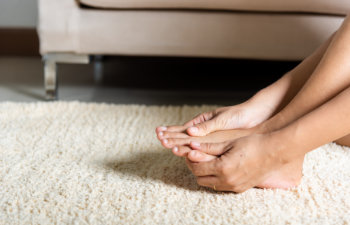Could I Have Bone Spurs On My Feet?

Pain in your foot or ankle can significantly hinder your ability to participate in daily activities. Whether you are walking, exercising or even standing, discomfort can take a toll on your quality of life. One potential cause of persistent foot and ankle pain is the presence of bone spurs.
Let’s explore what bone spurs are, the common symptoms associated with them and the treatment options available through Dr. Stuart J. Mogul, an NYC expert in foot and ankle surgery.
What Are Bone Spurs?
Bone spurs, or osteophytes, are bony projections that develop along the edges of bones. They are often a result of the body attempting to repair itself in response to joint damage caused by conditions like arthritis or repetitive stress. While bone spurs can develop in various parts of the body, they are particularly common in the feet, especially around the heel and toe areas.
Bone spurs are common, with prevalence increasing significantly with age. The Journal of Foot & Ankle Research claims that by age 70, almost all adults have bone spurs, and many people learn they have them incidentally during X-rays for other issues.
Common Symptoms of Bone Spurs
If you suspect you might have bone spurs, you’ll want to be aware of the common symptoms. Some of the signs to look out for include:
- Pain: The most noticeable symptom is usually pain, particularly during activities that put pressure on the affected area. You may experience sharp or aching discomfort that is aggravated by movement.
- Swelling: Inflammation can occur around the bone spur, leading to noticeable swelling in the area.
- Limited Range of Motion: Bone spurs can impede joint movement, making it difficult to perform certain motions without pain or stiffness.
- Numbness or Tingling: If a bone spur is pressing on a nerve, you might feel numbness or tingling in the affected foot.
- Changes in Walking Style: As pain increases, you may unconsciously adjust your walking pattern to avoid discomfort, which can lead to further problems.
Treatment Options for Bone Spurs
If you’re experiencing signs of bone spurs, it’s essential to consult a qualified podiatrist like Dr. Stuart J. Mogul. With over 25 years of experience in foot and ankle surgery, Dr. Mogul is experienced in diagnosing and treating a wide variety of conditions, including bone spurs. Treatment options may include:
- Conservative Measures: Initial treatments often include rest, ice, elevation and over-the-counter pain relievers to manage discomfort. Weight management can also help reduce stress on your feet.
- Physical Therapy: Targeted exercises and stretches can improve flexibility and strengthen the muscles in the feet, potentially alleviating pain associated with bone spurs.
- Orthotics: Custom orthotic devices can provide improved support and cushioning for your feet, helping to redistribute pressure and minimize pain.
- Minimally Invasive Surgery: For more severe cases or when conservative treatments fail, Dr. Mogul may recommend minimally invasive surgery to remove the bone spur. This approach leads to reduced healing time and excellent outcomes, allowing for a quicker return to your daily activities.
- Cosmetic Options: In cases where bone spurs affect the appearance of your feet, Dr. Mogul also provides cosmetic procedures to correct these issues.
FAQs about Bone Spurs
What causes bone spurs?
Bone spurs can be caused by various conditions, including arthritis, repetitive stress injuries and age-related wear and tear on the joints.
Are bone spurs always painful?
Not necessarily. Some individuals may have bone spurs without experiencing any discomfort, while others may find even small spurs lead to significant pain.
Can bone spurs go away on their own?
Bone spurs typically do not resolve independently. However, symptoms often can be managed through treatment.
Is surgery the only option for bone spurs?
No, many patients find relief through conservative measures, such as physical therapy and orthotics. Surgery is usually considered a last resort for those who do not respond to other treatments.
How can I prevent bone spurs?
Maintaining a healthy weight, wearing supportive footwear and avoiding repetitive stress can help prevent the formation of bone spurs.
NYC Bone Spur Treatment
If you’re suffering from foot or ankle pain, it’s crucial to consult a specialist to determine the underlying cause. Dr. Stuart J. Mogul offers personalized treatment options to address your specific needs, enabling you to regain mobility and enhance your quality of life. Don’t let foot pain hold you back; reach out today to schedule a consultation.
Posted on behalf of
1111 Park Avenue Suite 1B
New York, NY 10128
Phone: (212) 769-0066
Email: contact@footsurgerycenternyc.com
Monday - Friday 8:30 AM – 6:00 PM
